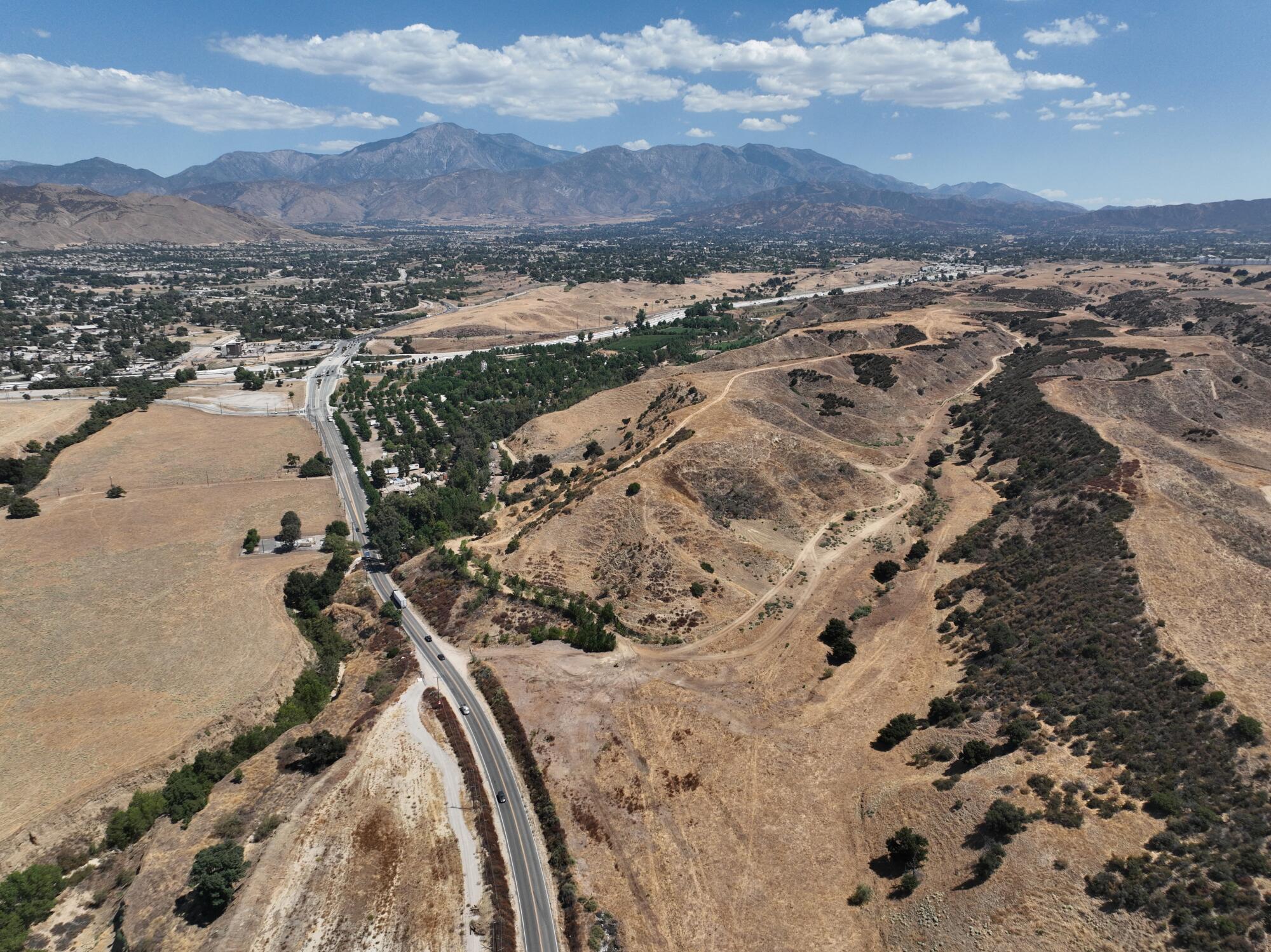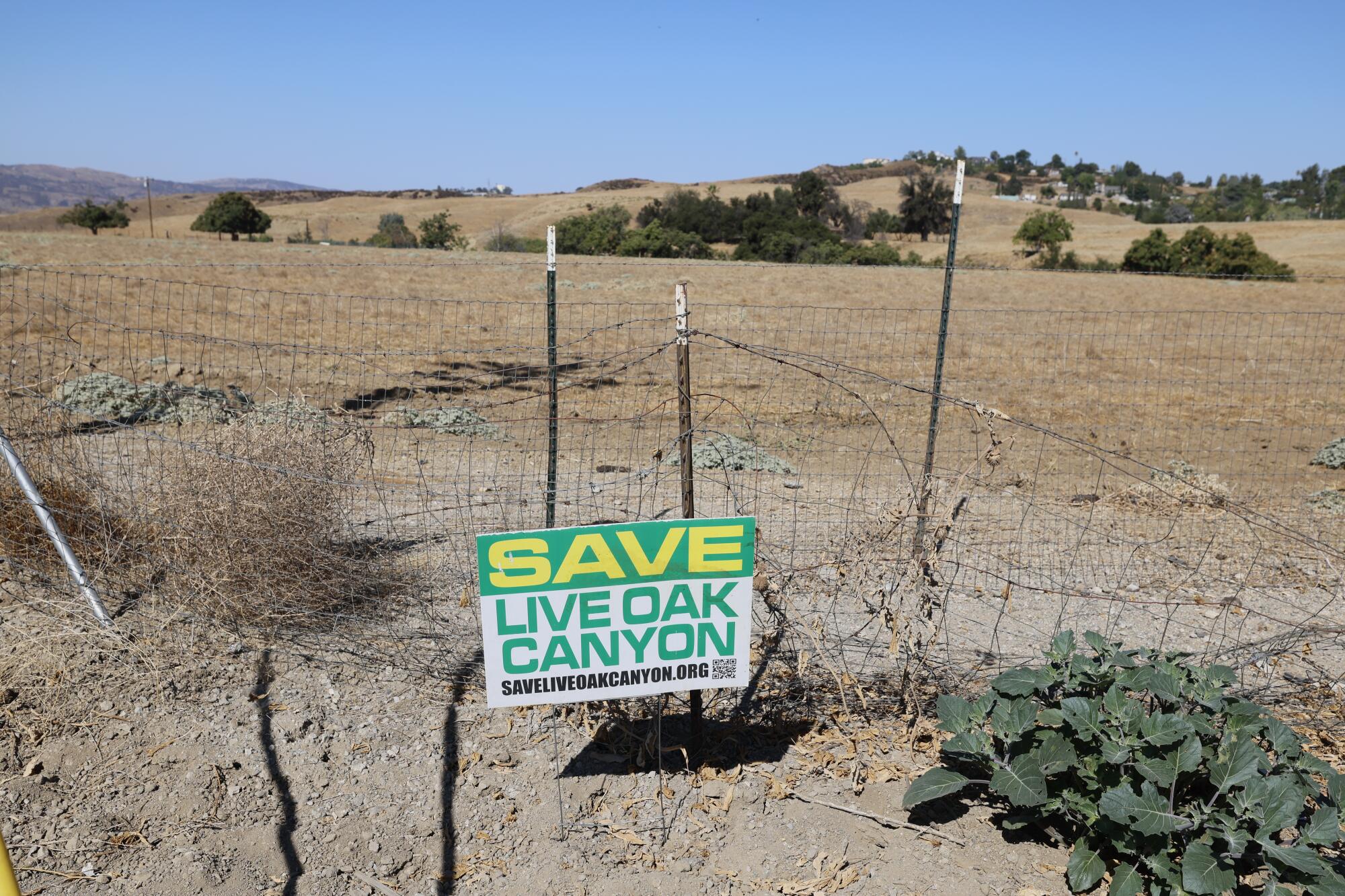When David Matuszak looks out over Live Oak Canyon from his four-acre horse ranch, he sees a sweeping view of fields and grazing cattle. For nearly 40 years, he has been riding along equestrian trails filled with coastal oaks, chamise and buckwheat and surrounded by the snow-capped mountains of the San Gorgonio Wilderness.
“This is one of the most beautiful areas in Southern California,” said the author and retired high school teacher, who is also president of the Friends of Live Oak Canyon, which he describes as a grassroots environmental homeowners association.
But Matuszak and others fear that could change if the city of Yucaipa gives the green light to build two huge warehouses in an undeveloped area about a mile from Matuszak’s farm. They say the project will destroy natural spaces and undermine the city’s rural character, increasing traffic congestion and air pollution. They fear it is part of an effort by city officials to turn Yucaipa into another Inland Empire logistics hub, dominated by huge fulfillment centers and rumbling diesel trucks.
“That’s what we worry about, that we’re the next Fontana, Ontario or San Bernardino,” said Kathy Sellers, a retired San Bernardino court reporter who has lived in Yucaipa for 38 years. “That’s why we all live here, to stay away from it.”
Jurupa Hills High School borders several large warehouses in Fontana. Some Yucaipa residents are opposed to plans to build a large warehouse there, saying Fontana and other communities have suffered due to the expansion of logistics warehouses.
(Myang J. Chun / Los Angeles Times)
San Bernardino and Riverside counties already have nearly 4,000 warehouses, spanning some 37 square miles — the largest contiguous cluster on Earth, it is estimated. a report Released last year by environmental groups, the sprawling region east of Los Angeles is located near freeways and railroad tracks that transport goods. Busy port of L.A. and Long Beach. The explosion in e-commerce during the COVID-19 pandemic further increased demand for logistics centers.
Warehouse development has increased raised concerns about poor air qualityincreased risk of cancer and the destruction of green areas that act as natural carbon sinks. More than 60 organizations have signed on, including Friends of Live Oak Canyon a letter He called the surge one of the most critical environmental justice issues facing the region and urged Governor Gavin Newsom to declare a state of emergency given its public health impacts.
Already, studies consistently rank the Inland Empire as the most influential. Worst air quality The area has the highest diesel particulate matter problem in the country. Timothy Mullins, who moved to Yucaipa 25 years ago to escape development in Redlands, said the area has struggled with high levels of diesel particulate matter.
He said, “The implementation of this project will put more burden on us and the health of the community will deteriorate.”
Until recently, Yucaipa was largely spared from such development. Now, a 363,000-foot warehouse near the border with Calimesa is set to be completed in the next few months. And the project currently being considered — called Pacific Oaks Commerce Center — would have two buildings totaling nearly 1 million square feet and, according to traffic studies, about 1,100 truck trips per day.
The project would be a financial boon for the city, which is struggling with a growing budget deficit. Officials plan to cut public safety and community services if voters fail to pass a bill raising the sales tax on the November ballot.
Benjamin Matlock, Yucaipa city planner and deputy director of community development, said the developers will pay about $14 million in impact fees and invest millions of dollars in infrastructure improvements, including building a water line and widening a section of Live Oak Canyon Road. He said that will help the city attract other projects to the area, including much-needed housing. He said the developers also have agreed to fund an aerial ladder truck for the Yucaipa Fire Department.

An aerial view of the site where developers hope to build two 1 million-square-foot warehouses in the Live Oak Canyon area of Yucaipa.
(Alan J. Shaben/Los Angeles Times)
The total cost of the infrastructure upgrades will exceed $37 million, which will be financed without using taxpayer money or bonds, according to Dan Floriani, co-founder of project developer Pacific Industrial. The project will include 96 acres of permanent open space, with a trail accessible to the public. He wrote in an email that an economic benefit analysis done by a third-party consultant estimates it will create 1,200 to 1,600 permanent jobs.
Edward Timmons, whose children are fifth-generation Yucaipa residents, once worked as a manager at a large fulfillment center in Rialto. He said the work was dominated by low-wage, low-skill jobs with a high rate of attrition. “Your average employee will stay there about three months; the average manager, four to six months,” he said. “It’s not a place where you make a career. It’s a place that fills vacancies until you find a better place to work.”
They also questioned whether the project would provide the long-term economic benefits the city hopes. The local logistics industry has cooled since the pandemic hit, shedding warehousing and storage jobs for the first time in more than two decades and increasing industrial building vacancies, according to the report. An LA Times report published earlier this year,
Timmons, who now works as a real estate broker and mortgage loan originator, pulled listings within a 30-mile radius of Yucaipa and calculated nearly 27 million square feet of vacant warehouse space, when it comes to warehouses over 250,000 square feet.
Timmons and other residents said that, while negotiations between the city and developers have been going on for four years, many locals didn’t learn about the proposal until it went before the Planning Commission in June. In July, the commission voted 3-2 to not recommend the project.
“Nobody wants that,” Timmons said.
For the project to move forward, Yucaipa’s City Council must approve it and update a 2008 plan that specified how the city’s freeway corridor — a 1,200-acre area bisected by Interstate 10 — should be developed. The council is expected to vote on Sept. 23.

Some residents say a proposal to build a massive shipping warehouse in Yucaipa threatens to turn the rural area into an Inland Empire logistics hub.
(Alan J. Shaben/Los Angeles Times)
Matlock, the city planner, said the 2008 plan already allows warehouses in certain areas. He said the proposed update would reconfigure where warehouses could be built from areas close to freeways to more isolated locations. He said developers “tried their best” to design the site near a wastewater treatment facility and hidden behind hills.
Christine Mohler, who was on the committee that drafted the 2008 Freeway Corridor Plan during two years of meetings, said the decision to zone retail, commercial and industrial activity next to the freeway was made intentionally, “so that people could travel along the freeway and shop and do things of that nature and not have as much of an impact on residential areas and land.”
He said the original plan called for the corridor’s interior to be designated for housing and open space, while the proposed update would put the warehouse project at its center, with housing surrounding it.
“It’s just absurd for that area,” he said. “So what we had originally planned, which we thought was very efficient, as non-invasive as possible, has turned into a giant warehouse center. And that’s not what we thought.”
Although the warehouse complex won’t be visible from the freeway, it will be visible from nearby trails and open spaces, said Sherly Leonard, president of the Redlands Conservancy. The nonprofit manages a 341-acre preserve about a half-mile from the proposed complex and another 70 acres nearby.
“The views are beautiful,” he said. “And it’s not just that they’re beautiful, they actually benefit the human psyche. Look at car commercials: They never show anybody driving through a warehouse district or even a neighborhood.”
The land set aside for the complex is privately owned and not open to the public. However, he said it is a wildlife corridor for mountain lions, coyotes, foxes, bobcats and the occasional bear.
“It would cause significant damage to that environment, that habitat and open the door for more things like that — that’s from a conservationist standpoint,” he said. “From anybody’s standpoint, it would introduce 18-wheelers to a freeway offramp that is already severely congested at many times of the day and there’s no way to mitigate that, you just have to deal with it.”
When Matuszak moved to Yucaipa in 1977 to teach exercise science and biomechanics at the local high school, the adjacent communities of San Bernardino and Redlands were dotted with orange groves and open fields where farmers grew strawberries and onions, he said.
“Now, these warehouses are spread out for miles and miles and they’re made of concrete — concrete roofs, concrete walls, parking lots and so on,” he said, adding that this has created a heat island effect that has raised local temperatures by several degrees, in addition to global warming.
“We are seeing that efforts have begun to expand this city, which is called the logistics capital of the world, into our region as well,” he said. “And we are extremely upset by this. We will do everything possible to prevent this from happening.”
















